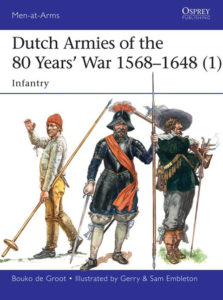BOUKO DE GROOT, who has a master’s degree in Egyptology from Leiden University in The Netherlands, is the author of Dutch Armies of the 80 Years’ War 1568-1841, which is being published in two volumes this year by Osprey Publishing (with illustrations by the father-and-son team of Gerry and Sam Embleton). De Groot has served in the Dutch army and currently lives in Germany, where he is a journalist. When not writing about current affairs, he continues to study and write about military history.
 1. How did you become interested in military history?
1. How did you become interested in military history?
Military history has always fascinated me. It’s a history of things, people, technology, and organization, all bound by big events and bloodshed. Far away from real war today, we tend to forget that our own history was written in blood. What interests me most is how people and armies at different times solved the same problems—for example, how to increase your own range while denying the other, or how to combine shock troops with screen troops. You’ll find that the solutions tend to be the same, but cast in the technology and organization of a particular time. History does repeat itself…and we keep insisting on re-inventing the wheel.
2. What inspired you to write this book?
The lack of American and English titles about the 80 Years’ War. There are just a handful, and none look at the actual army. It is overlooked despite critical events that occurred such as Prince Maurice of Orange-Nassau’s military revolution, the Dutch Republic’s 1581 Declaration of Independence, and England’s role during the first 25 years. It inspired 18th-century people to rise up against oppressors and got 19th-century military theorists talking about history. The Dutch reforms of the 1590s shaped the world’s history. Without them, Western armies wouldn’t have known drill. Without drill, those armies couldn’t have continually defeated larger forces elsewhere, and without that there wouldn’t have been Western hegemony. Historians today rather talk about technological inventions and socio-economics, but those would’ve been useless without military superiority through drill.
3. What kind of research do you do, and how much research do you do before you begin writing?
Historical research is like an hourglass. Along the top are many books and articles about a particular period or topic, some general, some specific. Your data set grows smaller and smaller until you get to the primary sources. Once there, you’ll discover that all those newer books only use a fraction of that primary material, so a whole new world opens up. I tend to start with recent works and trace back to the origins. I always check modern conclusions with primary sources and want to find at least two sources that prove a modern point. Otherwise I put it aside.
4. How long did you work on this book?
Too long! I verify everything, thus new leads are found everywhere. But this process results in a story that combines the historical (what) with the analytical (how) and the anecdotal (who). For example, I found that Maurice had effective infantry fire drill, retiring while firing; cavalry that charged with the saber; mobile skirmisher screens; and lightweight battalion guns. I included lists and maps of more than 100 battles of the war with descriptions of the organization of infantry units, combat drill, and equipment. These are all interspersed with stories about the men themselves.
5. What books are you reading right now?
Well, I just bought a book about motorized flight before the Wright brothers, a book about the Anglo-Dutch Wars, and one about the vicious battle for the Grebbeberg in May 1940, during the German invasion of The Netherlands, where Waffen-SS and Dutch conscripts went head to head. I tend to work though books by reading a chapter here and a chapter there.
6. How can readers learn more about you and your work?
When this volume hits the shelves (volume two follows this summer), the website 80YW.org will go live. It will list all the books, articles, and pamphlets I’ve used for my research. I’ll introduce new topics and look more closely at things mentioned in the book—for example, detailed descriptions of battles and raids. I hope people will visit the site to discuss matters and share new information. MHQ

